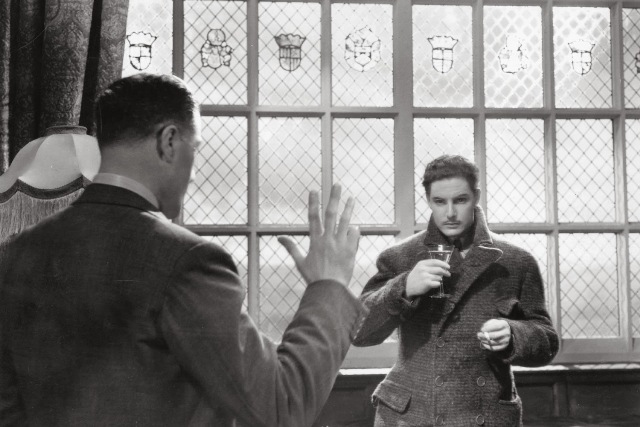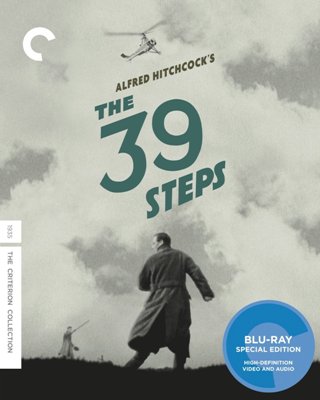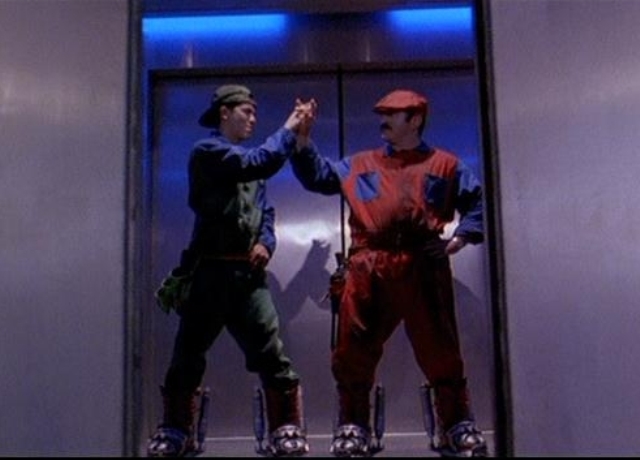Michael Bay is a difficult filmmaker to explain. His films are notable for being loud, bombastic, and sometimes very aggressively crass. What is even more peculiar is the fact that his film career has been a very successful one, even with all the criticism his films have received. He’s just been surprisingly good at making a lot of money. And does he deserve it all? While I can’t say that I particularly like his style of film making, I can’t deny that the man does have some talent behind the camera. In fact, you could say that Mr. Bay has a style all his own, and that’s something that’s hard to come by in an industry as homogenous as Hollywood. The only problem is that he has seemed to have wasted that same talent on what could be usually referred to as trash. I don’t know if he chooses the films he makes through artistic motives or economic ones, because most of his recent work makes me think that he just doesn’t care what he does. He’s shamelessly cashing in and relishing it at the same time. His filmography has turned into the cinematic equivalent of fast food, and himself being it’s Ronald McDonald. But even though Bay’s films are nothing but excuses for the director to indulge his cinematic excesses, every now and then he has managed to churn out something special. I for one really enjoy one of his earliest action thrillers called The Rock (1996), and his surprisingly smart 2005 thriller The Island. Unfotunately, if there are films that do not fit into that quality category, it would be his series of Transformers films.
When the first Transformers was released back in 2007, it became a surprise hit and launched what would eventually be one of the biggest moneymaking franchises in movie history. Unfortunately, that doesn’t mean that the films are any good. Based off of the popular toy line and 1980’s animated series of the same name, Transformers was basically a dumb but entertaining movie that was certainly geared towards being a crowd-pleaser. And honestly, to bring a story of giant, transforming robots to the big screen proved to be a perfect match for someone of Michael Bay’s talents. The storyline of the first film may not have retained the charming cheese of the earlier animated series, but it did deliver in the visuals, delivering some really impressive CGI effects along the way. Unfortunately, it seemed like Michael Bay’s ego took over in the follow-ups in the series, and the resulting films were an absolute mess. The second film was rightly derided for its lack of story and for it’s indulgences into sex appeal (particularly when it came to female lead Megan Fox) and racial stereo-typing. The third film tried to make up for the faults of the second, and the result was a movie that just felt like a bland retread of the first two. This slow devolution of the Transformers series represents a strong example of a franchise becoming the victim of its own success, and it’s a decline that really only seems to affect those of us who wanted to see more out of this franchise. Fans of the original series don’t even seem to recognize their beloved characters anymore, because Bay’s films have become something else entirely. Casual fans, however, seem to still be eating this stuff up, which is beyond me.
Now, after two critically derided films, we get the fourth installment of the series; Transformers: Age of Extinction. To Michael Bay’s credit, he has chosen this opportunity to shake things up a bit, possibly in order to bring some new focus into the series. Gone is former male lead Shia LaBeouf, who himself had become something of a joke in the series, along with pretty much every other recurring cast member. This is a good thing, in a way, because it puts more focus on the characters who should be the main characters, that being the Transformers themselves. Unfortunately, the new movie still puts way too much focus on it’s less interesting human cast. Thankfully, the balance between the two is much less of a problem. Overall, Age of Extinction is a step up from it’s predecessors, but not much of one. It works best as a reboot than as a continuation of the overall story, although the movie keeps reminding you of the previous movies at different points, so it makes the attempt at a reset pointless. And though it may have changed things up, it didn’t necessarily make the series any better; only a little less offensive. We are still a long way from making Transformers anything more than just a dumb action franchise.
So, how does this film build upon it’s predecessors? In the years following the events of the previous movie, both races of the Transformers (Autobots and Decepticons) have been hunted down and exterminated by humans in a genocidal revenge mission conducted by the CIA, led by their director, played by Kelsey Grammer, as a response to the carnage caused by the wars between the bots. All remaining Transformers have gone into hiding, hoping that salvation will come their way. Meanwhile in Texas, a barnyard inventor named Cade Yeager (Mark Wahlberg) comes across a rundown truck that he believes to be a hidden Transformer. When he awakens the dormant Autobot, he soon learns that he’s no ordinary Transformer, but Optimus Prime (voiced by Peter Cullen) the Autobot leader. Optimus helps Cade and his family escape the pursuing CIA task force, and rendezvous with his remaining crew, including the ever helpful Bumblebee. Unfortunately for them, they soon learn that they are being hunted down by more than just the CIA. A demented Transformer bounty hunter, named Lockdown (voiced by Mark Ryan) is also on their trail. Working together, Cade and Optimus become more aware of the stakes they are faced with, especially when they learn of the destructive force that Grammer’s agent character is after, and the means to which Lockdown will go to claim his trophies. What follows is a globe trotting adventure that takes the characters from the American heartland all the way to the cityscapes of China.
There isn’t much to the story as you can already tell. It’s just a series of events strung together for the purpose of bringing us from one action set piece to another. And there in lies the primary problem with this movie. Like the other films before it, there’s no real drama. The movie never gives us any real character depth and instead spends most of its time showcasing just how awesome it’s action scenes are. When that’s all your movie amounts to, it feels really hollow as a result. And given that this film runs at a very bloated 165 minutes, the action scenes become very tiresome after a while. Also, without the necessary character depth needed, we grow less interested in rooting for our main heroes, because there is little in them that we find interesting or redeeming. I think, in this case, that’s more of the fault of the writer, Ehren Kruger, than Michael Bay’s. He actually holds up his end by making the film look good, but that means little when the final script lacks anything worthwhile. It’s been the fundamental flaw of the series since day one, and unfortunately this new film has only made baby steps in trying to improve it.
If there’s something that does work in the movie’s favor, it’s that it doesn’t give into some of the series more obnoxious pitfalls from the past. Getting rid of Shia LaBeouf was a good move, as his character was never deserving of a central place in one movie, let alone three. The character of Sam Whitwhicky, played by LaBeouf, is one of cinemas most insufferable douchebags, and the fact that more screen time was devoted to him than a more deserving character like Optimus Prime was a real insult to the legacy of the original series. At least this time around, Bay has given Optimus more of the spotlight to work with, and something resembling a character arc. Also, a lot of the obnoxious comic relief is missing this time around, which is another benefit to this movie. There’s no annoying parent characters eating pot brownies; no Stepin Fetchit level racist stereotype Transformers; and no moments where we see the Transformers either defecating or letting their robot balls hang out. That being said, the movie doesn’t really add much to this story either. It’s sad to think that the most offensive elements of the series has also been what has defined it. Take all that away, and the result is just another generic action flick. What I would’ve liked to have seen is more of the Transformers universe explored in this movie; maybe even a film set entirely in another world other than our own. But, then again, that approach probably would’ve alienated it from the general audiences that produced the big grosses for them in the past. In that case, playing it safe may have been a poor decision on Michael Bay’s part.
Beyond the story, the remainder of the film is generally a mixed bag. Some of the film surprisingly works, but the rest is pretty much what is expected of the series. One thing that I did like in this movie, surprisingly, was the lead actor. Mark Wahlberg is a huge improvement over Shia, and he does make the most of a character that, again, is poorly written. Wahlberg kind of has the same gift as Nicolas Cage, where he can be entertaining and have a presence on screen, even when the movie and character itself is terrible. Another thing that I liked in this film was the collection of villains. Kelsey Grammer, of all people, actually brings a lot of menace to the film with his performance; very far removed from his days on Frasier. Lockdown is also a very effective villain here; far more intimidating than any other Transformer villain in the past. And part of the reason why the villainous characters work in this movie is because they are restrained in their characterizations. It’s a prime example where the movie benefits from a more subtle approach. Also, there are welcome additions to the Transformers team (voiced by the likes of John Goodman and Ken Watanabe) and they actually contribute to the story, rather than work as distractions. Unfortunately, the human characters, apart from Wahlberg, are just as generic as ever. The romantic couple (played by newcomers Nicolas Peltz and Jack Reynor) are particularly useless in this movie. It’s putting the human story ahead of the Transformer’s one that makes this film feel like a chore. Either Michael Bay is too stubborn to commit to a fully alien storyline, or he’s bound to a formula that he can’t escape from. In any case, it derails any chance this film has at making any change for the good in this series.
So overall, regardless of all the hard work that has been done to change course in the series, the results are still just the same. The best thing that I can say about the movie is that it at least tries to do things a little more subtly than the more excessive films in the series. It’s not obscene or crude, but it’s not interesting either. It’s the film that probably best represents the fact that this franchise is stretching itself thin, especially at almost 3 hours in length. Will audiences go for it? Probably. It doesn’t do anything that will make its base group of fans suddenly reject it. It may even win a few people over with it’s more low key approach. As for me, I’ve never been a Transformer fan before, and this movie did nothing to change that. At the same time, I do appreciate the fact that Michael Bay finally recognized that something needed to change in this series, and even if he made a half-assed attempt to change course, it was still aimed in the right direction. I only wish he had committed more fully and make a true Transformers film. We do still get ladies in short shorts and brief uses of gay and racial stereotypes, but to a smaller degree, so I guess that’s some kind of effort on his part. And like many other mega-hit franchises, the movie does leave room for a sequel, so I’m sure Michael Bay will be returning to the world of the Transformers again for the fifth time. Honestly, I wish Mr. Bay would consider handing the franchise over to others and get back to films that fit his style better; movies like The Rock. For now, unfortunately, Transformers: Age of Extinction is another film that is less than meets the eye.
Rating: 5/10




